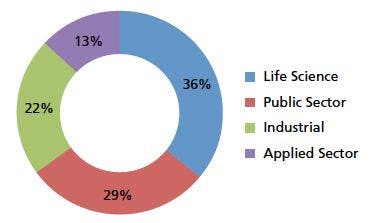UHPLC–MS/MS Analysis of Penicillin G and Its Major Metabolites in Citrus Fruit
LCGC North America
In recent years, Huanglongbing (HLB), or citrus greening disease, has devastated citrus crops throughout the world. Penicillin G has been used to treat HLB infected trees with promising results. However, the metabolites produced from the degradation of penicillin G are known to cause potentially life-threatening allergic reactions; therefore, the concentration and presence of the metabolites must be carefully monitored. We have built and revised an analytical method based on Ultra High Performance Liquid Chromatography in combination with Tandem Mass Spectrometry (UHPLC-MS/MS) in order to identify and quantitate penicillin G and its major metabolites, penillic acid and penilloic acid, in citrus fruit and juice. Here, we discuss the chromatographic conditions and revisions that improved the precision and accuracy of our measurements.
In recent years, citrus greening disease, also known as huanglongbing (HLB), has devastated citrus crops throughout the world. Penicillin G has been used to treat HLB-infected trees with promising results. However, the metabolites produced from the degradation of penicillin G are known to cause potentially life-threatening allergic reactions. Therefore, the concentration and presence of the metabolites must be carefully monitored. We have developed and revised an analytical method based on ultrahigh-pressure liquid chromatography (UHPLC) in combination with tandem mass spectrometry (MS/MS) to identify and quantitate penicillin G and its major metabolites, penillic acid and penilloic acid, in citrus fruit and juice. Here, we discuss the chromatographic conditions and revisions that improved the precision and accuracy of our measurements.
Citrus greening disease, also known as huanglongbing (HLB), has emerged as one of the largest agricultural threats worldwide. HLB is caused by bacteria in the genus Candidatus Liberibacter, which is transferred via the Asian citrus psyllid, an insect that feeds on citrus tree foliage. Although the disease was first discovered in China nearly a century ago, increased trade and globalization brought the disease-carrying psyllid to America and across the globe. After trees are infected, they exhibit stunted growth and sparse, yellowed foliage. Furthermore, the fruit of the trees are small, bitter, and discolored, and the majority will fall to the ground before they are ready to be harvested, thereby making the fruit unsellable (1,2).
The situation is looking particularly grim in Florida, where the economy is heavily dependent on citrus-growing operations. Florida accounts for 65% of the total citrus production in the United States, a figure worth an estimated $1.35 billion in revenue per year. The United States Department of Agriculture (USDA) and the Florida Agriculture Statistics Service (FASS) have continuously monitored citrus production in Florida and have identified an alarming trend: In 1997, citrus production in the state totaled 254 million boxes of citrus, but by 2014 growers only produced 96 million boxes as a result of HLB. Worse yet, citrus production dropped 29% between 2014 and 2015, and the trend is forecasted to continue by the end of 2016 (8,9).
As large citrus crops succumbed to the disease and hundreds of acres of trees perished, growers began to seek out loss-mitigation strategies and scientists focused on creating a permanent cure for HLB. One important strategy, pioneered in the 1970s, was to eliminate bacteria through the use of antibiotics, which showed promising results. Of the antibiotics tested, penicillin G was highly effective at eradicating Candidatus Liberibacter. Penicillin G has the benefits of being cheap and nontoxic to humans (3).
Although penicillin G is a promising treatment, there are problems associated with its well-characterized susceptibility to degradation; the β-lactam ring contained within penicillin G is responsible for its potent activity against bacteria, but it is also a highly strained and labile feature that leads to the molecular degradation of this antibiotic. Upon penicillin G’s degradation via autocatalysis or the presence of acids, bases, nucleophiles, and enzymatic activity, a number of biologically inactive metabolites are formed. Many metabolites are reported in the literature, including penillic acid, penilloic acid, penicilloic acid, penilloaldehyde, penicillamine, isopenillic acid, and more. These metabolites are the main cause of the penicillin allergy. The metabolites covalently bind to biological molecules, forming bioconjugates that cause immune-mediated responses (4). In fact, a penicillin allergy is the most common cause of drug-induced anaphylaxis, and it accounts for up to 1000 deaths per year (5). Therefore, the penicillin G metabolites have to be taken into consideration by the scientific community when using this antibiotic for any agricultural or biological application.
In this work, we used state-of-the-art liquid chromatography (LC)-based systems to monitor the degradation of penicillin G and the formation of its metabolites in various environmental conditions. We developed an accurate and precise analytical method to identify and quantify penicillin G and its metabolites in various citrus matrices.
Experimental
Extraction
Citrus fruit samples taken from the field were divided into two groups. The first group was frozen immediately at -80 °C; the second group was immediately juiced, and the juice was frozen at -80 °C. Frozen fruit was broken into smaller pieces and then homogenized using an industrial blender to form a fine powder. The extraction procedure following the homogenization was identical for juice and fruit samples. First, a 2-g sample was weighed and stabilized using 4 mL of phosphate buffer (PBS). Samples were spiked at 0.1, 0.25, 1, and 10 ng/mL of standard in triplicate, and shaken for 10 min. Then, 4 mL of hexane was added to each sample, and the samples were shaken for an additional 10 min. Samples were centrifuged and the hexane layers were removed. The aqueous layer was filtered using an Amicon Ultra 50,000 Mw membrane filtration device, and the resulted filtrate was then loaded onto an HLB, 6-cc, 200-mg solid-phase extraction (SPE) column. Next, 3 mL of acetonitrile was added to the HLB column to elute the analytes, which were then collected in a 50-mL centrifuge tube. A stream of nitrogen gas was used to blow down the acetonitrile, and then the samples were reconstituted with 800 µL of ammonium acetate buffer and transferred to LC vials (Figure 1) (6).
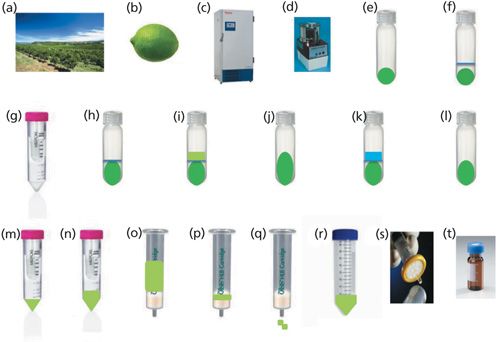
Figure 1: Step-by-step extraction method of penicillin G and its metabolites from citrus fruits: (a,b) Citrus fruit samples are collected from the field. (c) The samples are then frozen at -80 °C. (d) Frozen fruit is broken into smaller pieces and then homogenized using a blender and forming a fine powder. (e) 2 g of sample is weighed, (f) stabilized using 4 mL of phosphate buffer (PBS) and spiked at 0.1, 0.25, 1, and 10 ng/mL of standard in triplicate. (g) The samples are shaken for 10 min. (h) 4 mL of hexane is added. (i) The samples are shaken for an additional 10 min. (j) The samples are centrifuged at 4000 rpm for 15 min. (k) The hexane layer is removed. (l,m,n) The aqueous layer is transferred and filtered using an Amicon Ultra 50000 Mw membrane filtration device. (o,p) The resulted filtrate is loaded onto a huanglonbing (HLB), 6-cc, 200-mg SPE column. (q) 3 mL of acetonitrile is added to the HLB column. (r) Extracts are collected in a 50-mL centrifuge tube and a stream of nitrogen gas is used to blow down the acetonitrile. (s) The samples are reconstituted with 800 µL of ammonium acetate buffer and are passed through a PVDF filter and (t) transferred to LC vials.
LC Method
The analytical platforms we used were a Waters Acquity I-Class UPLC system coupled to a Sciex 6500 Qtrap triple-quadrupole mass spectrometer and a Thermo/Dionex UltiMate 3000 ultrahigh-pressure liquid chromatography (UHPLC) system coupled to a Thermo Q Exactive Orbitrap mass spectrometer. UHPLC systems provide shorter gradient delay times and less extracolumn band broadening, which can help lead to faster sample turnaround and taller, narrower peaks when compared to conventional LC systems. Improvements in resolution can also be achieved using UHPLC, and the higher operating pressures lead to greater column efficiency. The column chosen for this method was a 150 mm × 2.1 mm, 1.7-µm dp Waters Acquity C18 column. The length of the column was chosen based on the level of separation; therefore, a 150-mm column was preferred compared to a 100-mm or shorter column. The 1.7-μm particle size of the packing was also ideal because column efficiency increases as the particle size decreases. The amphiphilic nature of the analytes of interest means they are best suited for a reversed-phase system; therefore, the hydrophobic interactions provided by a C18 stationary phase offered sufficient separation. This column was maintained at a temperature of 40 °C. It had the additional benefit of being compatible with other analytical methods currently being used in our laboratory at the Florida Department of Agriculture.
Mobile-phase A was water with 0.1% formic acid, and mobile-phase B was acetonitrile with 0.1% formic acid. The 0.1% formic acid in each solvent served as a proton source for positive mode ionization in the electrospray ionization (ESI) source of the mass spectrometer. Acetonitrile was chosen because it has higher peak capacity (elution strength), lower pressure drops, and lower reactivity than other solvents, such as methanol. A ramped elution gradient beginning with 95:5 A:B and ending with 5:95 A:B was preferred over an isocratic gradient, as the increase in mobile phase strength would add to the separating power of the reversed-phase system. After the analytes enter the column, hydrophobic interactions with the C18 stationary phase were lost as the acetonitrile concentration increased in the mobile phase. Specific gradient parameters were modified for whole fruit citrus samples compared to citrus juice samples because of unique matrix components. For whole fruit, flow rates began at 0.2 mL/min of 95:5 A–B and increased to 5:95 Andash;B over the course of 10 min, then held at this mobile-phase composition for 5 min. For juice, a longer gradient was used starting with a 0.2-mL/min flow rate of 95:5 A–B, which was changed to 5:95 A–B over the course of 25 min, followed by a 6.9 min hold.
Results and Discussion
After an extensive search in the literature to understand the stability of penicillin G and identify what metabolites are produced when penicillin G degrades after treatment, we found that penillic acid, penilloic acid, and penicilloic acid (Figure 2) are the most known and highly cited metabolites. After purchasing these compounds, we injected them into the UHPLC–MS systems described in the Experimental section. Figure 3 shows the LC chromatograms of these injections, with typical retention times of 4.24, 5.10, 5.20, and 6.61 min reported for penillic acid, penilloic acid, penicilloic acid, and penicillin G, respectively. The elution order reflects the decrease in polarity of the analytes with increased retention time, as expected using a reversed-phase system. Penillic acid is eluted first, because the two carboxylic acid groups and the imidazoline heterocycle contained within its structure greatly increase its polarity relative to penilloic acid, penicilloic acid, and penicillin G.

Figure 2: Chemical structures of (a) penicillin G, (b) penillic acid, and (c) penilloic acid, the three compounds analyzed in this method.
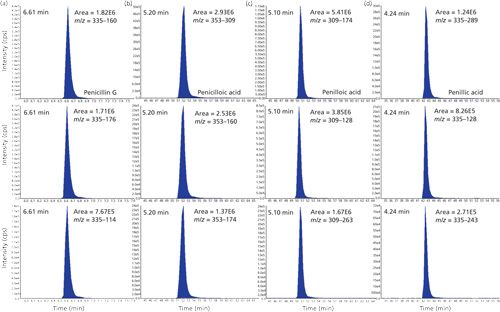
Figure 3: Extracted ion chromatograms collected at standard concentrations of 100 ng/mL in buffer (a−d) for penicillin G (m/z 160, 176, and 114), penicilloic acid (m/z 309, 160, and 174), penilloic acid (m/z 174, 128, and 263), and penillic acid (m/z 289, 128, and 243). Chromatograms were collected using the 6500 Sciex QTrap UHPLC–MS/MS platform. (Adapted from reference 4 with permission from the American Chemical Society.)
Next, we used these analytical platforms to characterize the penicillin G degradation at various environmental conditions. This was achieved to check the capability of our UHPLC–tandem mass spectrometry (MS/MS) instrument to identify the metabolites reported in the literature. For this, 100-ng/mL solutions of penicillin G were prepared in pH 2 and pH 12 solutions, and injected onto both platforms once hourly for a period of 24 h (Figure 4). Our results indicate that in acidic conditions, penillic acid is rapidly formed to a stable concentration of approximately 60 ng/mL. Penicilloic acid is formed to approximately 20 ng/mL, and penilloic acid is also formed to nearly 10 ng/mL. The mass balance shows approximately 90% of these metabolites are converted from penicillin G, and the remaining 10% is in the form of other minor metabolites (4). No penicillin G was detectable after 15 h. Using a first-order reaction fit, we determined the half-life of penicillin G to be 2.4 h in acidic conditions. Similarly, at pH 12, penicillin G degrades quickly and is not detectable after 10 h, with a half-life of only 1.35 h. Penicilloic acid is the predominant species formed at 90 ng/mL, and penilloic acid is formed to around 10%. Penillic acid was not formed in alkaline conditions. To simulate the degradation of penicillin G after it is applied to citrus trees, we prepared a 100-ng/mL solution of penicillin G in a natural lemon matrix, which has a pH of approximately pH 4. The stability of penicillin G was monitored once daily for a week. In matrix, penicillin G has a half-life of 0.9 days, with the major product of penillic acid forming at nearly 40 ng/mL. Penilloic acid and penicilloic acid were also produced, at around 20 ng/mL each. No other metabolites could be identified in this matrix. From these results, we determined that the most abundant metabolites were penillic acid, penilloic acid, and penicilloic acid, which agrees with the findings reported in the literature.
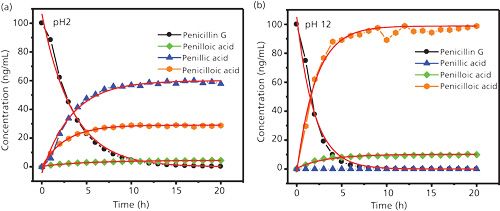
Figure 4: Degradation of penicillin G and formation of its major metabolites, penillic acid, penilloic acid, and penicilloic acid, at (a) pH 2 and (b) pH 12. (Adapted from reference 4 with permission from the American Chemical Society.)
We applied this method to a citrus fruit field sample taken from a tree treated with penicillin G, and were able to identify penicilloic acid, penilloic acid, and penillic acid, but penicillin G was not detectable. These findings confirm the results of the degradation studies, as the three major metabolites were identified in the field sample. An additional unknown peak was identified as well, with a retention time of only 4.09 min, which is a shorter time than that for than penillic acid. Our MS data indicated the compound had a mass-to-charge ratio (m/z) of 335, which is the expected m/z of isopenillic acid. Isopenicillic acid differs from penillic acid only in the opening of its ring structure, and isopenicillic acid features a free thiol. Because its polarity is higher than penillic acid, it is expected that isopenillic acid will be eluted earlier. From these conclusions, we determined the unknown peak to be isopenillic acid, although no standard was available for confirmation.
Identification and Quantitation of Penicillin G and ItsMetabolites in Whole Fruits
From the above degradation studies and field sample analysis, we determined that penillic acid, penilloic acid, and penicilloic acid were the major metabolites formed in citrus matrix from the decomposition of penicillin G. However, penicilloic acid is known to undergo decarboxylation into penilloic acid and is eluted in close proximity to penilloic acid. To avoid this potential problem, penicilloic acid was left out of our screen. To validate our extraction and the analytical method described above, we spiked orange, grapefruit, and lemon samples with the analytes of interest at four concentration levels. For quantitation, we created a six-point matrix-matched standard curve using a 1/x-weighted quadratic curve. For penicillin G, we incorporated the penicillin G-D5 internal standard, and quantitated it using a 1/x linear curve. Overall, our absolute spike recoveries were within the 50–70% range for each analyte in each matrix. At the lowest level, 0.1 ng/mL, recoveries were excellent, with the exception of penicillin G in lemon; however, the low recoveries can be attributed to the higher acidity of the lemon matrix compared to orange or grapefruit. When using the deuterated penicillin G-D5 internal standard to correct for recovery losses and matrix effects, penicillin recoveries were approximately 100%. Therefore, this method was validated with a limit of detection (LOD) of 0.1 ng/mL (6).
Quantitation of Metabolitesin Orange Juice
A large portion of the citrus fruit produced in Florida is processed into juice, so we attempted to validate the analytical method for the quantitation of penicillin G, penillic acid, and penilloic acid in this matrix. Following the same strategy as the whole fruit samples, we quickly noticed that recoveries for penillic acid were below 50%. After examining the chromatographic peaks, it was clear that an unknown matrix component was coeluted with penillic acid, which severely interfered with our ability to quantify this analyte. Our signal intensity for this analyte was cut in half as a result of this matrix interference. To achieve better resolution between the unknown matrix component and penillic acid, we decided to extend the duration of the LC method, and increased the gradient from 10 min to 25 min, increasing our run time from 20 min to 32 min. Retention times using this method moved to 6.08, 7.95, and 11.05 min for penillic acid, penilloic acid, and penicillin G, respectively. Interestingly, the isomers of penilloic acid, (R)- and (S)-penilloic acid, became partially resolved, forming a double peak; however, this had no effect on our abilities to quantitate this analyte.
The chromatogram for penillic acid showed a much cleaner background, and penillic acid was sufficiently resolved from the unknown matrix component. Therefore, the extended elution gradient was successful, and quantitation of penillic acid in citrus juice was obtainable. Absolute recoveries improved from less than 50% to approximately 70% when the elution gradient was changed to 25 min. However, the unique matrix components of orange juice are highly variable from sample to sample, so the LOD was raised to 0.25 ng/mL for penillic acid using this method (10).
Incorporation of Internal Standards
Using the methods described above for citrus fruit and orange juice, the absolute recoveries were approximately 70% for each analyte. However, when the recovery of penicillin G was corrected using the penicillin G-D5, recoveries improved to approximately 100%. To improve the recoveries of our method, we decided to incorporate deuterated internal standards for each analyte. For this, we collaborated with O2si Smart Solutions to prepare penillic acid-D5 and penilloic acid-D5. After injecting these new internal standards on our LC–MS system, the retention times of the deuterated standards were 0.04–0.08 min lower than for the nondeuterated standard. This phenomenon is well known, and is caused by the stronger bond interactions between the deuterium and carbon atoms than with hydrogen and carbon atoms. This physicochemical change is responsible for the slight decrease in affinity for the reversed-phase LC column (7). After the incorporation of the internal standards, recoveries improved dramatically, from 50–70% to nearly 100% for each analyte. Therefore, the accuracy of the method was greatly improved, and the precision of our recoveries remained high with incorporation of the deuterated standards.
Summary
We have developed a highly accurate and precise analytical method for the quantitation and identification of penicillin G and two of its major metabolites, penillic acid and penilloic acid, in citrus fruit and juice matrices. Significant matrix interferences affected the quantitation of penillic acid in orange juice, so the elution gradient was extended, solving the problem. Absolute recoveries of the method were approximately 70%, but with the incorporation of internal standards for each analyte, recoveries were nearly 100%. This method is currently in use by the Florida Department of Agriculture and Consumer Services to determine residue levels of penicillin G, penillic acid, and penilloic acid in citrus trees affected by the citrus greening disease after penicillin G treatment.
References
- M. Nageswara-Rao, M. Irey, S.M. Garnsey, and S. Gowda, J. Biosci.38, 229–237 (2013).
- C. Teixeira Ddo, C. Saillard, S. Eveillard, J.L. Danet, P.I. da Costa, A.J. Ayres, and J. Bove, Int. J. Syst. Evol. Microbiol.55, 1857–1862 (2005).
- M. Zhang, C.A. Powell, L. Zhou, Z. He, E. Stover, and Y. Duan, Phytopathology101, 1097–1103 (2011).
- F. Aldeek, D. Canzani, M. Standland, M.R. Crosswhite, W. Hammack, G. Gerard, and J.M. Cook, J. Agric. Food Chem.64, 6100–6107 (2016).
- R.S. Gruchalla and M. Pirmohamed, N. Engl. J. Med. 354, 601–609 (2006).
- F. Aldeek, M.R. Rosana, Z.K. Hamilton, M.R. Crosswhite, C.W. Burrows, S. Singh, G. Gerard, W. Hammack, and J.M. Cook, J. Agric. Food Chem.63, 5993–6000 (2015).
- E. Stokvis, H. Rosing, and J.H. Beijnen, Rapid Commun. Mass Spectrom.19, 401–407 (2005).
- F. Aldeek, D. Canzani, M.Standland, W. Hammack, J.M. Cook, M. Crosswhite, and G. Gerard J. AOAC Int. accepted (2016).
Daniele Canzani and Fadi Aldeek are with the Florida Department of Agriculture and Consumer Services, Division of Food Safety in Tallahassee, Florida. Direct correspondence to: fadi.aldeek@freshfromflorida.com
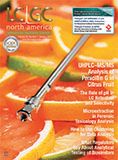
Analytical Challenges in Measuring Migration from Food Contact Materials
November 2nd 2015Food contact materials contain low molecular weight additives and processing aids which can migrate into foods leading to trace levels of contamination. Food safety is ensured through regulations, comprising compositional controls and migration limits, which present a significant analytical challenge to the food industry to ensure compliance and demonstrate due diligence. Of the various analytical approaches, LC-MS/MS has proved to be an essential tool in monitoring migration of target compounds into foods, and more sophisticated approaches such as LC-high resolution MS (Orbitrap) are being increasingly used for untargeted analysis to monitor non-intentionally added substances. This podcast will provide an overview to this area, illustrated with various applications showing current approaches being employed.
Silvia Radenkovic on Building Connections in the Scientific Community
April 11th 2025In the second part of our conversation with Silvia Radenkovic, she shares insights into her involvement in scientific organizations and offers advice for young scientists looking to engage more in scientific organizations.

